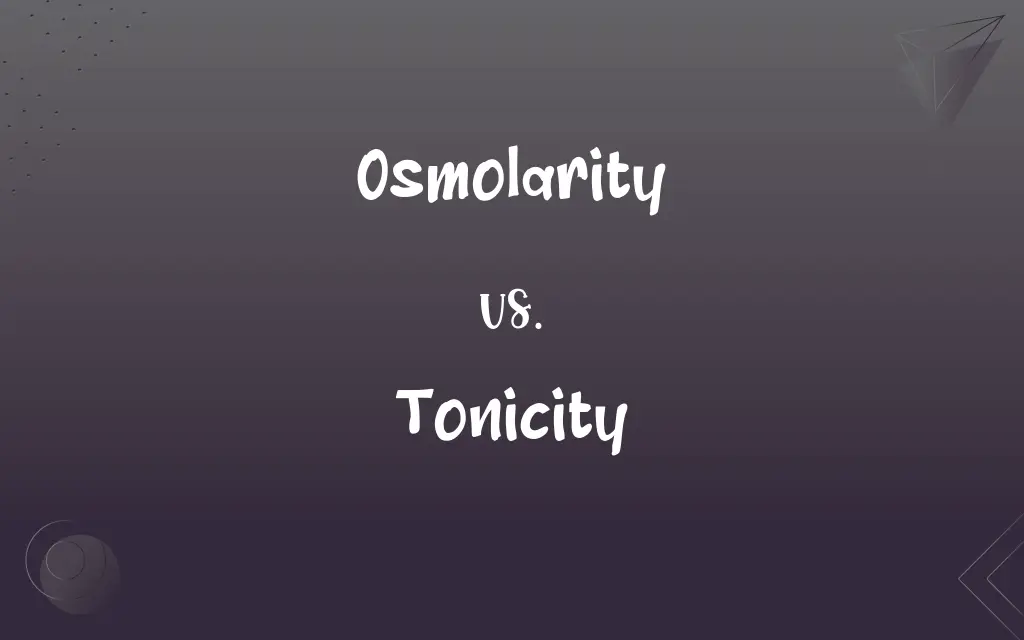Osmolarity vs. Tonicity: What's the Difference?
Edited by Janet White || By Harlon Moss || Updated on October 13, 2023
Osmolarity measures solute concentration in a solution, while tonicity describes a solution's effect on cell size due to osmotic pressure.

Key Differences
Osmolarity is a term that quantifies the concentration of solute particles in a solution. Tonicity, on the other hand, is a qualitative measure that describes the effect of a solution on the osmotic movement of water, and thus, on the stability of cells (either causing them to shrink, swell, or remain the same).
Both osmolarity and tonicity are crucial concepts in understanding cellular behavior in different solutions. Osmolarity plays a pivotal role in determining the direction of water movement across a semi-permeable membrane, while tonicity is particularly significant in predicting the behavior of cells in a solution.
To clarify, osmolarity is a precise measurement, given in osmoles per liter (Osm/L). Tonicity, however, cannot be measured in exact units because it is a relative term, often described as isotonic, hypertonic, or hypotonic, depending on whether cells in the solution remain stable, shrink, or swell, respectively.
Osmolarity is relevant in various scientific fields, including chemistry and biology, for analyzing solution concentrations. On the other hand, tonicity is vital in medical and biological contexts, where understanding cellular responses to external solutions is paramount.
While osmolarity is applicable to any solution, tonicity is exclusively used to describe solutions when they are outside of a cell, thus influencing cellular behavior. Osmolarity's significance spans a wider array of scientific applications, whereas tonicity’s utility is primarily tethered to biological and medical spheres.
ADVERTISEMENT
Comparison Chart
Definition
Measures solute concentration.
Describes effect on cell size due to osmosis.
Units
Expressed in Osm/L.
No specific units; relative term.
Application
Applicable to all solutions.
Relates only to cellular behavior.
Quantitative/Qualitative
Quantitative measure.
Qualitative description.
Field Relevance
Relevant in various scientific fields.
Primarily important in biology/medicine.
ADVERTISEMENT
Osmolarity and Tonicity Definitions
Osmolarity
Osmolarity refers to the total concentration of solute particles in a solution.
The osmolarity of the saline solution was 300 mOsm/L.
Tonicity
Tonicity describes how an extracellular solution can change the volume of a cell by affecting osmosis.
The tonicity of the solution caused the cells to swell.
Osmolarity
Osmolarity influences the direction of water movement across membranes.
Due to its high osmolarity, water moved into the cell.
Tonicity
It is a relative term often classified as hypertonic, isotonic, or hypotonic.
The blood cells shriveled up due to the hypertonic tonicity of the surrounding solution.
Osmolarity
It considers all solute particles, permeable or not, in the solution.
Osmolarity takes into account both sodium and potassium ions in the measurement.
Tonicity
Tonicity only considers non-penetrating solutes when discussing cellular behavior.
Despite similar osmolarity, the tonicity of the two solutions differed significantly.
Osmolarity
Osmolarity helps determine the osmotic pressure of a solution.
A solution with lower osmolarity will have a lower osmotic pressure.
Tonicity
Tonicity is crucial in maintaining cellular stability.
Isotonic solutions are often used in medical settings to maintain cell tonicity.
Osmolarity
It is expressed in osmoles per liter (Osm/L).
To prevent cellular damage, the osmolarity of IV solutions should be considered.
Tonicity
It influences whether cells in a solution will shrink, swell, or remain the same size.
In a hypotonic solution, cells may lyse due to its tonicity.
Osmolarity
(chemistry) The osmotic concentration of a solution, normally expressed as osmoles of solute per litre of solution.
Tonicity
Normal firmness or functional readiness in body tissues or organs.
Tonicity
The sustained partial contraction of resting or relaxed muscles.
Tonicity
(medicine) The normal presence of tone or tension in a muscle or organ; tonus
Tonicity
(sciences) The ability of nonpenetrable solutes in a solution to exert an osmotic pressure upon a membrane
Tonicity
The state of healthy tension or partial contraction of muscle fibers while at rest; tone; tonus.
Tonicity
The elastic tension of living muscles, arteries, etc. that facilitate response to stimuli;
The doctor tested my tonicity
FAQs
Can osmolarity affect cell size?
Yes, osmolarity can dictate water movement across cell membranes, influencing cell size indirectly.
Is tonicity quantitatively measured?
No, tonicity is qualitative, often described as isotonic, hypertonic, or hypotonic, not quantified with units.
How does osmolarity relate to osmotic pressure?
Osmolarity is directly proportional to osmotic pressure; a higher osmolarity indicates higher osmotic pressure.
What is osmolarity?
Osmolarity measures the total concentration of solute particles in a solution, expressed in osmoles per liter (Osm/L).
Can solutions with similar osmolarity have different tonicity?
Yes, since tonicity considers only non-penetrating solutes in relation to cellular behavior, while osmolarity considers all.
Does tonicity always relate to cellular contexts?
Yes, tonicity specifically refers to how a solution influences the osmotic movement of water in or out of a cell.
How does tonicity affect red blood cells?
Tonicity can cause red blood cells to become crenated (in hypertonic), lysed (in hypotonic), or remain stable (in isotonic).
What happens to a cell in a hypertonic solution?
In a hypertonic solution, cells typically shrink due to water exiting to balance tonicity.
How is osmolarity calculated?
Osmolarity can be calculated by multiplying the molarity of a solution by the number of particles a solute yields in solution.
Why is tonicity important in medical fields?
Tonicity is crucial for ensuring solutions administered to patients don’t cause harmful cellular swelling or shrinking.
How is tonicity defined?
Tonicity describes the ability of an extracellular solution to make a cell swell or shrink through osmosis.
Is osmolarity relevant in medical applications?
Yes, osmolarity is vital in medical contexts like formulating IV solutions to avoid causing cellular stress.
Can osmolarity impact biological systems?
Absolutely, osmolarity influences cellular osmosis, impacting bodily fluid balance and cellular health.
Does osmolarity consider permeable solutes?
Yes, osmolarity considers all solute particles, whether they can permeate a membrane or not.
Can tonicity be related to plant cells?
Yes, tonicity can dictate water movement in plant cells, affecting turgor pressure and cell shape.
How does osmolarity affect the movement of water?
Water moves from an area of lower osmolarity to higher osmolarity through a semi-permeable membrane.
What is the impact of tonicity on animal cells?
Tonicity can control water movement across animal cell membranes, influencing cell stability and integrity.
Why is isotonic tonicity vital in healthcare?
Isotonic solutions prevent cellular damage by not altering cellular water balance, maintaining physiological stability.
Can two solutions have the same osmolarity?
Yes, solutions can have equal osmolarity, meaning they have the same solute concentration.
Is osmolarity vital in chemistry?
Yes, osmolarity is pivotal in chemistry for studying solution concentrations and predicting solute behavior.
About Author
Written by
Harlon MossHarlon is a seasoned quality moderator and accomplished content writer for Difference Wiki. An alumnus of the prestigious University of California, he earned his degree in Computer Science. Leveraging his academic background, Harlon brings a meticulous and informed perspective to his work, ensuring content accuracy and excellence.
Edited by
Janet WhiteJanet White has been an esteemed writer and blogger for Difference Wiki. Holding a Master's degree in Science and Medical Journalism from the prestigious Boston University, she has consistently demonstrated her expertise and passion for her field. When she's not immersed in her work, Janet relishes her time exercising, delving into a good book, and cherishing moments with friends and family.































































